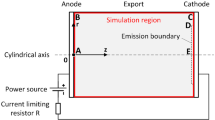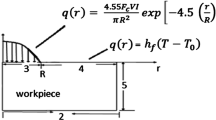Abstract
Observations of the discharge gap were conducted to investigate the discharge plasma motion in reciprocated traveling wire electrical discharge machining (RT-WEDM). It was found that a discharge plasma continuously slides on the surface of a workpiece. An oscillating moving heat source is proposed to better describe the characteristics of discharge plasma motions. Based on an oscillating moving heat source, a novel thermal-fluid coupling model by adopting a level-set method is proposed to investigate the formation of a crater and the effects of machining parameters on craters. Discharge plasma sliding, latent heat, and molten pool forces are comprehensively considered in the proposed model. Simulation and experimental results show that a sliding discharge plasma has a significant effect on a crater. At the end of a discharge, a considerable proportion of molten materials remains in the molten pool. A high sliding speed of discharge plasma can lead to a low aspect ratio in a crater and a thin recast layer. Due to discharge plasma sliding, an increase in pulse duration can significantly increase the length of a crater and decrease the aspect ratio, while an increase in peak current can significantly increase the depth and volume of the crater. Simulation and experimental results also show that morphologies of the simulated crater and experimental craters are consistent, verifying the feasibility and accuracy of the proposed simulation model in explaining the mechanism of crater formation in RT-WEDM.






















Similar content being viewed by others

References
Ho KH, Newman ST, Rahimifard S, Allen RD (2004) State of the art in wire electrical discharge machining. Int J Mach Tools Manuf 44(12):1247–1259
Zhang G, Chen Z, Zhang Z, Huang Y, Ming W, Li H (2014) A macroscopic mechanical model of wire electrode deflection considering temperature increment in MS-WEDM process. Int J Mach Tools Manuf 78:41–53
Yan H, Liu Z, Li L, Li C, He X (2017) Large taper mechanism of HS-WEDM. The International Journal of Advanced Manufacturing Technology 90(9):2969–2977
Yuan J, Wang K, Yu T, Fang M (2008) Reliable multi-objective optimization of high-speed WEDM process based on Gaussian process regression. Int J Mach Tools Manuf 48(1):47–60
Kojima A, Natsu W, Kunieda M (2008) Spectroscopic measurement of arc plasma diameter in EDM. CIRP Ann 57(1):203–207
Yue X, Yang X (2021) The role of discharge plasma on molten pool dynamics in EDM. J Mater Process Technol 293:117092
Yue X, Yang X, Li Q, Li X (2020) Novel methods for high-speed observation of material removal and molten pool movement in EDM. Precis Eng 66:295–305
Yue X, Yang X, Kunieda M (2018) Influence of metal vapor jets from tool electrode on material removal of workpiece in EDM. Precis Eng 53:278–288
Kunieda M, Xia H, Nishiwaki N, Kinoshita N (1992) Observation of arc column movement during monopulse discharge in EDM. CIRP Ann 41(1):227–230
Tang J, Yang X (2017) A novel thermo-hydraulic coupling model to investigate the crater formation in electrical discharge machining. J Phys D Appl Phys 50(36):365301
Esteves PMB, Wiessner M, Costa JVMR, Sikora M, Wegener K (2021) WEDM single crater asymmetry. The International Journal of Advanced Manufacturing Technology
Zhang Y, Liu Z, Pan H, Qiu M (2021) Motion characteristics of discharge channel in WEDM. Mater Manuf Process 36(5):583–598
Oßwald K, Lochmahr I (2020) Effect of the relative velocity between electrodes in high speed wire EDM (HSWEDM). Procedia CIRP 95:325–330
Hou PJ, Guo YF, Sun LX, Deng GQ (2013) Simulation of temperature and thermal stress filed during reciprocating traveling WEDM of insulating ceramics. Procedia CIRP 6:410–415
Descoeudres A, Hollenstein C, Wälder G, Perez R (2005) Time-resolved imaging and spatially-resolved spectroscopy of electrical discharge machining plasma. J Phys D Appl Phys 38(22):4066–4073
Xia H, Hashimoto H, Kunieda M, Nishiwaki N (1996) Measurement of energy distribution in continuous EDM process. Journal of the Japan Society for Precision Engineering 62(8):1141–1145
Weingärtner E, Wegener K, Kuster F (2013) Influence of workpiece circumferential speed in wire electrical discharge machining. Procedia CIRP 6:238–243
Ikai T, Hashigushi K (1995) Heat input for crater formation in EDM. Proceedings of International Symposium for Electro Machining-ISEM XI, pp 163–170
Li Q, Yang X (2020) Study on arc plasma movement and its effect on crater morphology during single-pulse discharge in EDM. The International Journal of Advanced Manufacturing Technology 106(11):5033–5047
Funding
This research is financially supported by the National Natural Science Foundation of China (Grant No. 52075333). The authors also gratefully acknowledge the Leading with Wisdom Advanced Manufacturing Research Center, Pinghu, Zhejiang Province, for their kind assistance in this work.
Author information
Authors and Affiliations
Contributions
Xue-Cheng Xi was responsible for conceptualization, methodology, funding acquisition, and writing and editing. Zi-Lun Li was responsible for software, validation, formal analysis, and writing of draft. Qiang Gao was responsible for formal analysis and validation. Ya-Ou Zhang’s contribution was formal analysis and writing of original draft. Wan-Sheng Zhao’s contribution was supervision and writing and editing.
Corresponding author
Ethics declarations
Competing interests
The authors declare no competing interests.
Additional information
Publisher’s note
Springer Nature remains neutral with regard to jurisdictional claims in published maps and institutional affiliations.
Rights and permissions
Springer Nature or its licensor (e.g. a society or other partner) holds exclusive rights to this article under a publishing agreement with the author(s) or other rightsholder(s); author self-archiving of the accepted manuscript version of this article is solely governed by the terms of such publishing agreement and applicable law.
About this article
Cite this article
Xi, XC., Li, ZL., Gao, Q. et al. Observation and simulation investigation for the crater formation under discharge plasma movement in RT-WEDM. Int J Adv Manuf Technol 126, 145–162 (2023). https://doi.org/10.1007/s00170-023-10931-2
Received:
Accepted:
Published:
Issue Date:
DOI: https://doi.org/10.1007/s00170-023-10931-2



